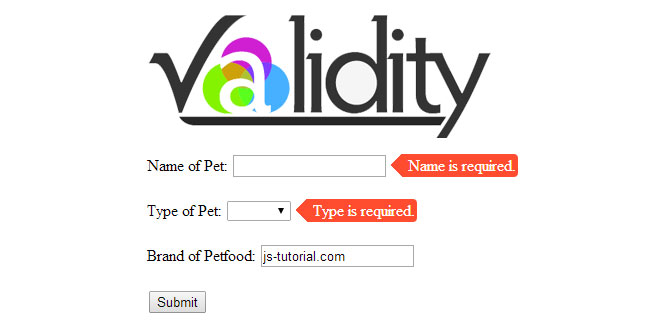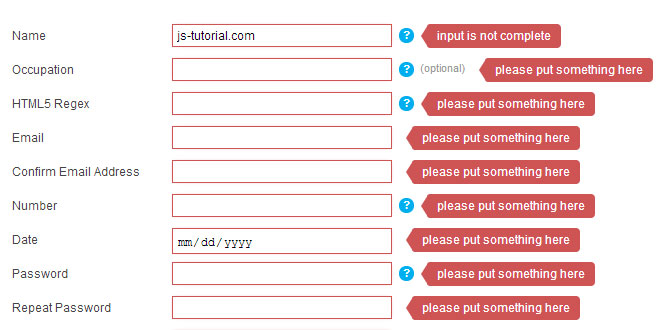- Overview
- Documents
jQuery Form Validate is a jQuery plugin that helps validate your HTML forms. It takes validation rules from the HTML 5 data attributes applied to each input. For example, let's assume we have a first_name text input in our form. We want our first name field to be required and have a length of at least 5 characters. The HTML markup would look like this:
<input type="text" id="first_name" name="first_name" class="required" data-min-chars="5">
xnxx popüler pornolar rus porno porno
Source: vmichnowicz.com
1. INCLUDE JS FILES
<script type="text/javascript" src="https://ajax.googleapis.com/ajax/libs/jquery/1.9.0/jquery.min.js"></script> <script type="text/javascript" src="jquery.formvalidate.js"></script>
2. HTML
<form id="form-1" method="post" action="" class="form-horizontal"> <fieldset> <legend>Basic Form <a href="#example-1" class="btn btn-mini"><i class="icon-eye-close"></i> Code</a></legend> <div class="control-group"> <label for="required" class="control-label">Anything</label> <div class="controls"> <input type="text" id="required" name="required" data-trim data-min-length="2" title="Anything" class="required" maxlength="128"> </div> </div> <div class="control-group"> <label for="optional" class="control-label">Optional</label> <div class="controls"> <input type="text" id="optional" name="optional" title="Optional" maxlength="128"> </div> </div> <div class="control-group"> <div class="controls"> <input type="submit" class="btn btn-small btn-primary" id="submit-1" value="Submit"> </div> </div> </fieldset> </form>
3. JAVASCRIPT
// Validate on form submission
$('#form-1').submit(function(e) {
e.preventDefault();
$(this).formvalidate({
failureMessages: true,
successMessages: true,
messageFailureClass: 'label label-important',
messageSuccessClass: 'label label-success',
onSuccess: function(form) {
alert('Form #1 is valid!');
}
});
});
Filters & Validations
jQuery Form Validate includes two main groups of functions, "filters" and "validations". Filters modify the value of an input before it is validated. The most common filter is trim. This function will remove all the leading and trailing white space of a form inputs value. This is most commonly used to make sure that a user actually entered something instead of just spaces. The full list of filters is as follows:
- trim() - Remove all leading and trailing white space
- strtoupper() - Convert text to upper case
- strtolower() - Convert text to lower case
After all filters have been processed, then the validations are run. A validation looks at the value of the form input and an optional list of parameters, and then does some processing. The full list of validation functions along with their parameter requirements is as follows:
- required() - Make it so form input is required.
- requiredIf( string element id ) - Require an input only if a dependent element has a value.
- betweenNumeric( float minimum, float maximum ) - See if a value is between a minimum and maximum value.
- numChars( int length ) - Validate that a string is exactly a certain number of characters in length.
- minChars( int minimum ) - Validate that a string is at least a certain number of characters in length.
- maxChars( int maximum ) - Validate that a string is no more than a certain number of characters in length.
- numOptions( int minimum ) - Make sure a user selects exactly the provided number of checkboxes or multi-select form inputs.
- minOptions( int minimum ) - Make sure a user selects at least a provided number of checkboxes or multi-select form inputs.
- maxOptions( int maximum ) - Make sure a user selects no more than a provided number of checkboxes or multi-select form inputs.
- email() - Make sure a user entered a valid email
- date( string format ) - Make sure the user entered a valid date in a valid date format. Format must be written as either "YYYY-MM-DD", "MM-DD-YYYY", or "DD-MM-YYYY".
Breaking Down The Data Attributes
jQuery Form Validate uses the data attributes applied to your form inputs input to figure out which form validations to run.
Publically Available Properties
CSS selector of parent element of success and failure message. By default this is div. This selector is relative to each input. Starting at the input we go through each parent and see if it matches the provided selector. This will tell us were to place each error and success messages. For this reason it is nice to wrap each set of labels and inputs in some sort of container element.
Wrap success and failure messages inside this element. By default this is <span />.
Boolean option to display failure messages. Defaults to true.
Boolean option to display success messages. Defaults to false.
CSS class(es) applied to failure messages. Defaults to error. Multiple CSS classes can be applied by through space delineation i.e. error error-text.
CSS class(es) applied to success messages. Defaults to success. Multiple CSS classes can be applied by through space delineation i.e. success success-text.
CSS class(es) added to inputs that did not pass validation. Defaults to error. Multiple CSS classes can be applied by through space delineation i.e. error error-text.
CSS class added to inputs that did pass validation. Defaults to success. Multiple CSS classes can be applied by through space delineation i.e. success success-text.
Set the language for error and success messages. Defaults to en for English. Deutsch de, English en, Español es, and Pirate pirate are available.
Publicly Available Methods
preProcess [ function function(form, options, inputFailureClass, inputSuccessClass, messageFailureClass, messageSuccessClass, messageElement) ]
This function is run before any form validation processing. By default this function removes all failure and success classes from inputs and and removes all failure and success messages.
postProcess [ function function(form, inputs) ]
This function is run after all form filter and validation rules are gathered. By default nothing is run in this function.
onSuccess [ function function(form, inputs, options) ]
This function is run after a form has successfully been validated. By default the form is submitted. If you wanted to AJAX your form data this would be the place to add that logic.
onFailure [ function function(form, inputs, options) ]
Filters
All filters are run before validation functions. Filter function modify the input data and return the new data. Each function accepts two parameters, the form input, and an array of parameters. Even though no parameters are used for the default filter function, if you decided to create your own filter you can take advantage of this feature.
trim [ function function(input, params) ]
The trim function removes all leading and trailing whitespace.
strtoupper [ function function(input, params) ]
This function converts all text to uppercase.
strtolower [ function function(input, params) ]
This function converts all text to lowercase.
Validations
Validation functions simply check to see if an input is valid. Validation functions return the boolean true orfalse. Each function accepts two parameters, the form input, and an array of parameters. Each validation function references an associated error message. Validations, are applied by including data attributes in an HTML form input. Data attributes are dashed versions of these method names below. For example, therequiredIf method would need a HTML data attribute of required-if.
betweenNumeric [ function function(input, params) ]
This function is used to determine if the input value is between two provided numbers.
date [ function function(input, params) ]
This function checks to see if a valid date was submitted. Dates are accepted in one of three formats: "YYYY-MM-DD", "DD-MM-YYYY", "MM-DD-YYYY". The date string being validated may use a delimiter of either -, /,,, or ..
email [ function function(input, params) ]
This function checks to see if a valid email was submitted. Email is validated using the regular expression /^[A-Z0-9._%+-]+@[A-Z0-9.-]+\.[A-Z]{2,4}$/i.
numChars [ function function(input, params) ]
This function checks to see if an input is exactly the provided length.
minChars [ function function(input, params) ]
This function checks to see if an input is at least of a provided length.
maxChars [ function function(input, params) ]
This function checks to see if an input is no longer than the provided number of characters.
numOptions [ function function(input, params) ]
minOptions [ function function(input, params) ]
This function checks to see if multi-select or checkbox inputs have at least a provided number of selections.
maxOptions [ function function(input, params) ]
This function checks to see if multi-select or checkbox inputs have no more than a provided number of selections.
int [ function function(input, params) ]
This function checks to see if a valid integer was provided.
required [ function function(input, params) ]
This function checks to see if any value was provided and the input is not blank.
requiredIf [ function function(input, params) ]
This function checks to see if any value was provided and the input is not blank only if the dependent input has a value.
lessThan [ function function(input, params) ]
This function checks to see if a value is less than the provided number.
greaterThan [ function function(input, params) ]
This function checks to see if a value is greater than the provided number.
Complete Object Reference (Hierarchy)
- preProcess
- postProcess
- onSuccess
- onFailure
- messageParent
- messageElement
- failureMessages
- successMessages
- messageFailureClass
- messageSuccessClass
- inputFailureClass
- inputSuccessClass
- cssParamDelimiter
- language
-
localization
-
en
-
success
- default
- betweenNumeric
- date
- numChars
- minChars
- maxChars
- numOptions
- minOptions
- maxOptions
- int
- float
- required
- requiredIf
- lessThan
- greaterThan
-
failure
- default
-
success
-
en
-
filters
- trim
- strtoupper
- strtolower
-
validations
- betweenNumeric
- date
- dateAfter
- dateBefore
- numChars
- minChars
- maxChars
- numOptions
- minOptions
- maxOptions
- int
- float
- required
- requiredIf
- lessThan
- greaterThan
 JS Tutorial
JS Tutorial




